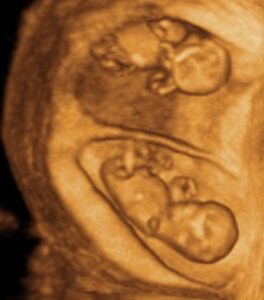
Difference between identical and fraternal twins
Before establishing the biological origin differences between identical and fraternal twins, let’s make a quick note on the etymology of both words.
Etymologically both terms have the same origin (Latin gemellicium) and were used interchangeably to refer to children born in the same delivery. The only difference was the use of the term fraternal twin in the popular speech twin and identical twin in the cultivated speech. However, the semantic evolution of both words has been accompanied by the numerous advances in the field of genetics and knowledge of the development of the human embryo. In fact, since they differ in the latest edition of the dictionary of the RAE:
Índice
Definition of fraternal and identical twin
- Identical twin: Born on the same delivery and originated from the same egg.
- Fraternal twin: Born on the same delivery and more particularly on a double delivery and originated from different eggs.
What is a fraternal twin?
So, we talk about fraternal twins in the case of different eggs and different sperm that have resulted in two births in the same delivery that is brothers born at the same time, but with no other peculiarity.
What is an identical twin?
However, the identical twins are genetically identical because they come from the same egg and sperm that in a very early stage of its development, was divided in two and led to two separate individuals. This causes twins share the same DNA, and therefore the same sex. Strictly speaking they are clones. Although we must not forget the effects the environment has on the expression of genes and therefore the development of individuals that can produce a discrepancy between the twins. In fact, identical twins have different fingerprints. That is, identical twins share the same “raw material” but the environment will shape it leading to different individuals.
In gynecological terms we speak of monozygotic identical twins (zygote one originated from a single egg and sperm that subsequently divides into two) and dizygotic fraternal twins (two originate two eggs and zygotes different sperm). Regardless of their origin, twin pregnancies are also classified according to whether or not each fetus has its own placenta, amnion (amniotic mono or bi) and chorion (mono-or dichorionic). Fraternal twin’s pregnancies are dichorionic and biamniotic. In the case of identical twins can take all possibilities.
Statistically, how many pregnancies are identical and fraternal twins?
Regarding the incidence rate, 1 in 80 pregnancies are spontaneously double, being two-thirds of fraternal twins and a third of identical twins. In fact, it is thought that twin pregnancies occur in a greater proportion, but are not detected as one of the embryos stops in a very early embryonic stage. There are both environmental factors (i.e.: nutrition) and genetic predisposition to an increased chance of twins. Obviously the use of assisted reproductive techniques has been a key factor in increasing the incidence rate as more than one embryo is transferred, increasing fraternal twins pregnancies, specifically because they come from different zygotes.
Finally it is worth mentioning the importance of identical twins in biomedical research as they provide clues to determine the origin or predisposition to certain genetic diseases.
MORE RELATED INFORMATION
- Avoiding multiple pregnancy: Why is it important to avoid pregnancy of twins or triplets?
- High risk pregnancy
Dr. Belén Lledó, IBBIOTECH Medical Director of Instituto Bernabeu.
To found out the next topics for our forum: follow us on facebook or twitter.
You can arrange an online consultation or book an appointment at Instituto Bernabeu.

